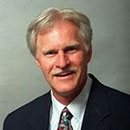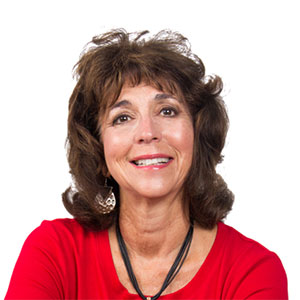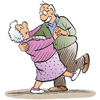'The music brings back memories': Seniors dance for fun and fitness
Published in Senior Living Features
The rules are simple in Cyndi Dorber's line-dancing classes. Show up. Move. Have fun.
Dorber, a professional dance instructor, has found a niche teaching older students at senior centers and retirement communities throughout the Dallas area.
"Movement and music make the elderly feel young," Dorber says. "The music brings back memories, and the movement helps build stamina and muscle."
The benefits are available to anyone. Participants learn a few basic steps, but the most important, by far, is the first one: stepping onto the dance floor. The best thing about her classes may be that you don't have to be any good to enjoy them.
"I just try to move to the music," says Martha Calderon, 82, one of Dorber's students. "Sometimes I forget the steps, but that's fine. I enjoy it."
As Satchel Paige, baseball's ageless pitcher-philosopher, used to say, "Dance like nobody's watching."
Dorber's lessons last an hour, with frequent two-minute breaks. On one recent Monday at Atria Canyon Creek, an independent senior living community in Plano, her 11 students formed three lines on the dance floor. A few of them wore pedometers to track their steps. One woman, apparently taking no chances, wore two, one clipped to each of her turquoise sandals.
Punching up song after song on her iPad, Dorber shouted out instructions:
"Let's shimmy!"
"Shake, shake, shake."
"Toe slap, toe slap. Point, point, point. Toe, heel, toe, heel. Point, point, point."
The choreography was ... imperfect. There wasn't much shimmy in the shimmies. Halfway through each song, the three lines were more like squiggles. Some people line-danced. Others line-shuffled.
None of that mattered, Dorber assured the class.
"There are no mistakes in line-dancing," she says. "Just variations."
FINDING THE RHYTHM
Dorber more or less fell into her career. Growing up, she preferred sports to dancing. "My mom threw me a basketball and sent my two sisters to ballet school," she says.
In the late 1970s, while working in Morristown, N.J., she was hired as a cheerleader for the New York Cosmos, a pro soccer team. She stayed just three months - long enough to realize "I had a real passion for dancing." She soon started giving lessons.
Three years ago, recognizing a community need and a market opportunity, she designed a class specifically for seniors. They now make up three-quarters of her clientele. "I never knew how much I'd love working with the elderly," says the Addison resident, 60. "They're just so loving and happy to see me."
Louise Pierson, 85, has been attending Dorber's weekly class at Atria Canyon Creek for about a year. Before that, she says, "I couldn't dance a step. I was raised a Baptist. Dancing wasn't allowed." Now she's a big fan.
"Your brain and your feet have to work together," she says. "You have to listen to the beat and pay attention to the steps. It helps you mentally as well as physically.
"And if you miss a step, it's no big deal. You just look at the person next to you and catch up. The important thing is that you're moving for an hour."
CLASSIC BEATS
Dorber's library of dance tunes is rooted in the 1950s and pre-Beatles '60s, reminding today's seniors of the long-ago days of carefree youth. "Rock Around the Clock" by Bill Haley & His Comets. "Fly Me to the Moon" by Frank Sinatra. "The Wanderer" by Dion, "Que Sera, Sera" by Doris Day. "Be-Bop-A-Lula" by Gene Vincent.
There's the occasional country classic: "All My Ex's Live in Texas" by George Strait, "Boot Scootin' Boogie" by Brooks & Dunn.
Also in the mix, oddly, is Lady Gaga's "Poker Face."
"That's scary!" one dancer in the back row uttered during the song's robotic, synth-pop opening bars.
And there's one selection that's conspicuously fitting: "Old Bones" by George Burns.
HEAD-TO-TOE BENEFITS
The physical benefits of dancing, like any cardiovascular activity, are well-documented. Lately, medical research has revealed important psychological and mental benefits as well, especially for older people.
Dancing relieves stress. It stimulates the body's production of serotonin, a neurotransmitter associated with feelings of well-being and happiness.
Most significantly, it may reduce the risk of dementia. A study by scientists from the Albert Einstein College of Medicine, published in 2003 in the New England Journal of Medicine, found that people between 75 and 85 who danced regularly were much less likely than their peers to develop Alzheimer's or other forms of dementia.
Some scientists theorize that dancing helps keep the mind healthy by challenging participants to think and react quickly, correctly and creatively. That stimulates the continuing creation of new neural pathways in the brain. What we use, when it comes to brain cells, we're less likely to lose. In other words, dancing keeps us on our toes, literally and figuratively.
Peggy Smith, 73, says that's one of the things she enjoys about Dorber's classes.
"Getting old isn't for wimps," she says. "Life can begin in your 70s. But you have to work at it. There are always new things to learn, new places to go, new things to try, new people to meet. Every day can be a new adventure. You just have to have the right attitude."
Or as Satchel Paige put it, "Age is a case of mind over matter. If you don't mind, it don't matter."
Visit The Dallas Morning News at www.dallasnews.com


















Comments